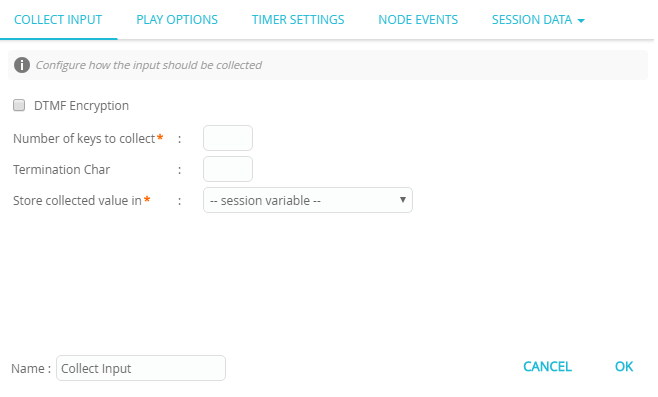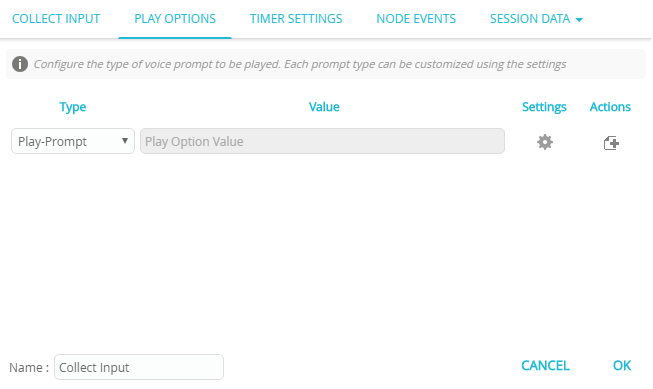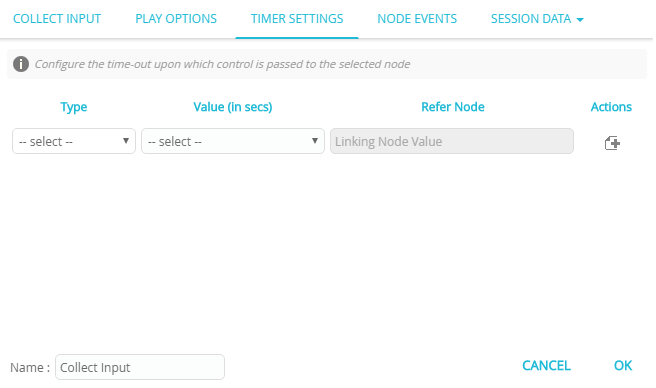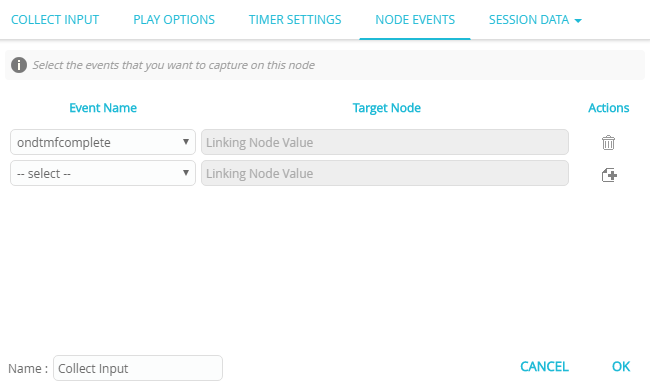Voice: Collect Input (deprecated)
Allows collecting user input as DTMF keystrokes within the flow. The input may be of fixed length (example, 6 digit pins) or variable length followed by a # stroke. The user input can be stored in a variable for further processing in the flow. DTMF encryption is supported.
Using this node in a voice flow
For example, accepting a credit card number in a voice call from the user input.
The older version of voice nodes are deprecated. If you are using an older version and wish to switch to the newer version, contact Customer Support.

The options of collect input node are:
| Node Options | Description |
|---|---|
| COLLECT INPUT | Collect input options helps you configure the keys to collect information, store, and terminate character. |
| PLAY OPTIONS | Play options help you configure a voice file to the node. |
| TIMER SETTINGS | Timer options help you configure the time-out upon which the control is passed to the selected node. |
| NODE EVENTS | Node options help you configure the events that you want to trigger on this node. |
COLLECT INPUT
The collect input screen allows you to collect user responses in a voice call.

Following are the options of collect input screen:
- DTMF Encryption: Select this option to encrypt the DTMF selection.
- Number of keys to collect: Enter the number of keys to collect from the user's response.
- Termination Char: Enter the termination character after which the user's response is not recorded.
- Store collected value in: Select a session variable from the drop-down to store the values.
PLAY OPTIONS
The play options screen allows you to configure a voice file to the node.

To configure the play options, follow these steps:
- Select Type from the drop-down.
- Click Settings icon. A popup screen is displayed with additional configuration options.
* **Session Variables**: If you select **static variable**, the text box is enabled to enter the value.
* **Offset (Secs)**: Enter the offset time in seconds after which the voice will start playing.
* **Duration**: Enter the time in seconds. The voice file will be played for the specified duration.
* **User Assets**: Select this option to select the language and voice file.
* **+**: Click **+** option to configure additional options.
- Click x to close the screen.
- Click + icon to add additional options.
TIMER SETTINGS
The timer settings screen allows you to configure the time-out upon which the control is passed to the selected node.

| Type | Description |
|---|---|
| call | This option helps you terminate the flow from this node after the specified time-out seconds. To enter the time in seconds, follow these steps: 1. Select call from the Type drop-down. 2. Select static variable from the Value (in secs) drop-down. 3. Enter the value in seconds. 4. Click + icon to add other fields. |
| menu | This option helps you terminate a menu after the specified time-out seconds. To enter time in seconds, follow these steps: 1. Select menu from the Type drop-down. 2. Select static variable from the Value (in secs) drop-down. 3. Enter the value in seconds. |
| dtmf | This option helps you terminate a dtmf after the specified time-out seconds. To enter time in seconds, follow these steps: 1. Select dtmf from the Type drop-down. 2. Select static variable from the Value (in secs) drop-down. 3. Enter the value in seconds. |
NODE EVENTS
The node events screen allows you to configure the events that you want to trigger on this node.

| Event Name | Description |
|---|---|
| onplaycomplete | This event is triggered when the voice is played completely. |
| ondtmfcomplete | This event is triggered when dtmf is completed. |
| onnoinput | This event is triggered when an input is not provided. |
Properties / Params configuration
Properties
| Property | Description |
|---|---|
| Label | The name of the node represented as a string. A node can be renamed by changing the contents of the Label field. |
Params
| Parameter | Description |
|---|---|
| Session Data | The Session Data shortcut leads to the Session Data / Custom Logs configuration. Session Data can set one or more Session Params upon entering or leaving the node. Custom Logs can record one or more Session Params upon entering or leaving the node. This is useful for debugging purposes. |
Updated 4 months ago
